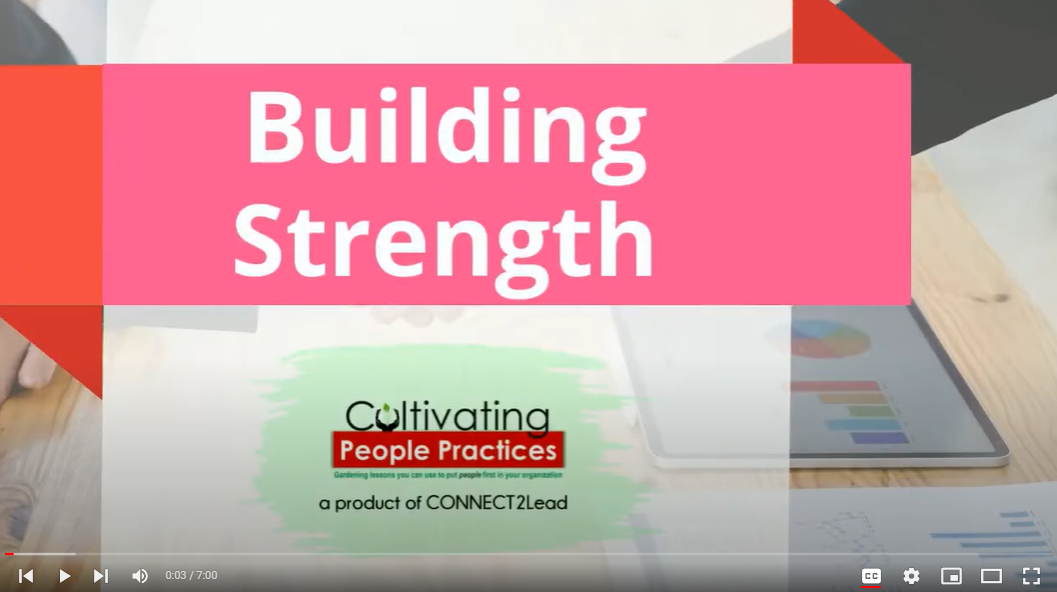Cultivating People Practices to Build Strength
Transcript:
Have you ever known someone who has a green thumb? They just seem to have a way with plants. Plants respond to them, they grow healthier and stronger for certain people. You know, the same is very true when it comes to growing people inside an organization. Certain managers, certain companies seem to do a much better job of creating environments where people can thrive. The people in those companies or on those teams are happier. They're more productive, they're more engaged.
They care more about their work and they produce better quality output.
Maybe it would be fair to say that those managers or those companies have a green thumb. They have a knack, but it's deliberate. This is no accident when this happens. And there are certainly things that you can do for the people around you, that would help them to be nourished and to thrive. It all starts from the very, very beginning. As you're hiring and onboarding people, it's important to plan ahead and to be very deliberate in preparing the ground, your culture for them so that they can thrive.
This is true with any type of gardening, but it's especially important when you're growing in bales of straw. The plants that aren't going to do well, starting directly from seeds as direct soil plants, they are going to be transplanted. You started them indoors. I start some of mine as early as January. Celery likes a good long start and I have an outbuilding, so they are over there in the outbuilding in a good dirt, a growing medium.
Sometimes I have to transplant them into larger pots, before I ever put them into the straw bales. And when they're in that dirt, the seedlings can begin to grow first covered and then when they sprout, I put them under a grow light and that gives them just enough warmth to be able to grow and get a good root system before I transplant them into the straw bales.
The reason that it's especially important to get some of these plants ready and to give them plenty of time to become stronger before they go into the bales of straw is simply that. bales of straw don't have the same level of nutrients that a soil would.
In fact, you have to amend soil too, but straw bales, you're starting from scratch. You start with nitrogen that gets everything nice and warm inside and helps the soil or the straw, rather, to decompose and be a good medium in the way that soil would be. And then depending on what plant you're growing, you might also have to add some other amendments and so for very heavy eating plants, the kind that need lots and lots of nutrients, the typical compost that I might use might not be enough when I'm growing them in dirt and giving them a good strong start that helps them by the time I transplant them into the straw bales.
For example, with my tomatoes, I am giving them a good, healthy dose of calcium. I do that by saving egg shells and then grinding them into a fine powder. And I put that right into the dirt where I plant the tomato seed and it begins to grow for several weeks before I ever transplant it out into the straw bales when the bales themselves are ready and when the weather is appropriate for them and we're certain that there won't be any more frost. The seedlings have the very best chance of growing when they've been nurtured and taken care of indoors.
And then I put them outside for a few days, take them out from under their grow lights, take them from their controlled environment, and I set them outdoors in the dirt that they have been growing in to harden them off. That helps them to become acclimated to the new climate where they're going to be living, before I ever transplant them into the bales of straw. Now, of course, not all plants need to be transplanted. Lettuce, for example, grows very rapidly and in just about any conditions, so long as it's not too hot outside.
So those will be a direct sow, but because the straw bales aren't fully ready, I do give those plants a little bit of dirt when I plant the seed. It just gives them a nicer opportunity to flourish and to not have to overcome odds that they would otherwise be working against. And then, long term throughout the season, I also have to take into account what each and every plant is going to need to be effective. I cater to the individual needs of every plant.
Certain plants need lots and lots of water. And rather than relying exclusively on the soaker hoses for those plants that are going to need a deep root watering, I use old cartons. That's a milk carton that you see there with the bottom cut off and I'll just stick the hose right in there about once a week and let the the water be directed down deep, directly into the roots. I put those in before I ever do the transplanting because I wouldn't want to interfere with the roots of the plant when I put it in there.
And the very same way that I'm describing what you need to do for these little plants that go into straw bales, you'll want to think about doing the very same thing with the people that you're trying to nurture, the ones that you want to give the very best environment to so that they can thrive and grow. After all, they they are coming to depend on you. And it is up to you how much production, how much connection you're going to have with each and every one of those folks.

